 |
Aerial Bombs |
Personnel
Mission Reports
Pilot's Information File - March 1945
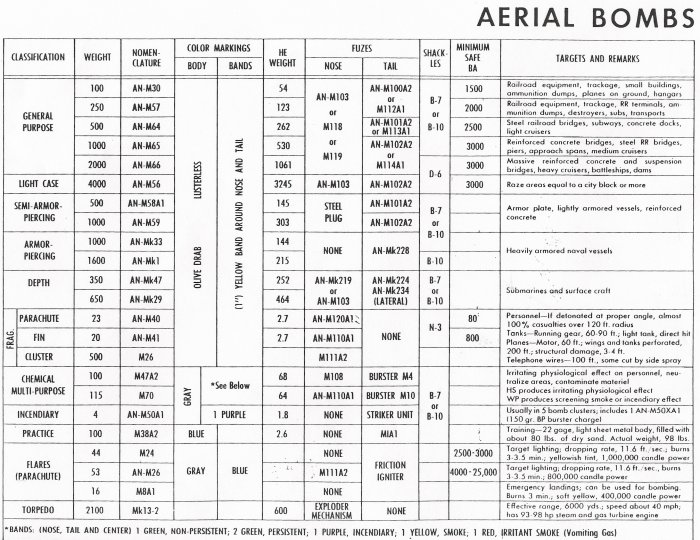
Printable Aerial Bomb Chart
-
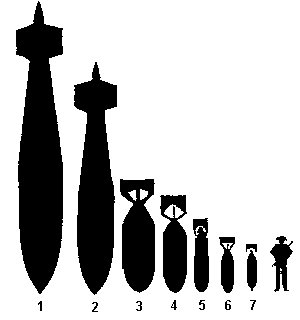 British and American Bombs of WWII
British and American Bombs of WWII
- RAF 22,000 lb Grand Slam, the largest high-explosive bomb ever made
- RAF 12,000 lb Tallboy, used for breaking through the concrete roofs of U-boat pens
- USAAF 4000 lb Blockbuster
- USAAF 2000 lb Blockbuster
- USAAF 1000 lb armor-piercing bomb
- USAAF 500 lb standard demolition bomb
- USAAF 100 lb bomb with nose fuse; shell could also be filled with white phosphorous to make the "Kenney Cocktail"
- RAF 22,000 lb Grand Slam, the largest high-explosive bomb ever made
- General Purpose/High Explosive Bombs
- The standard bombs used by the 8th Bomber Command from September 1942 were the five General Purpose types: the M30 100lb, M31 300lb, M43 500lb, M44 1000lb and M34 2000lb. Generally, 500lb, 1000lb, and 2000lb bombs were carried for industrial targets and the others for airfields. The 8th Air Force used 1000lb and 2000lb bombs for attacks on submarine pens, but these had little effect on the vast concrete fortifications that sheltered the U-boats most of the damage was done to the surrounding port area.
The General Purpose (GP) bombs used in the early missions were fitted with quarter second delay tail fuses with an extra tenth of a second fuse in the nose. In a report in December 1942, after the raid on Lille, it was calculated that 30 percent of the bombs dropped had failed to explode because the arming mechanisms had frozen up after being exposed the damp conditions on the airfields overnight. Standard Operating Procedure was soon changed so that fuses were installed just before take off. Eventually, to avoid accidents in landing, fuses were to be inserted only when the bombs were securely fixed into the aircraft.
In 1943, a new set of GP bombs were produced: the M57 250lb, M64 500lb, M65 1000lb and M66 2000lb. These accounted for most of the bombs dropped in the final year of the war. In January 1945, experts recommended 250lb GP bombs to be used against synthetic oil plants, ammunition dumps and oil storage facilities. the 100lb bomb was recommended for attacking railway yards and runways.
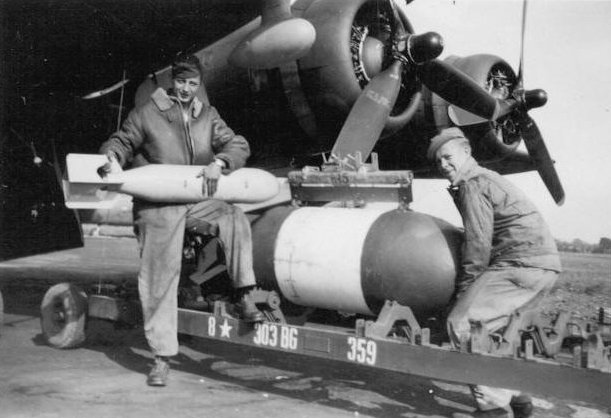
Unknown 359th BS Ground Crewmen Loading Bombs
- Incendiary Bombs
- Originally, the only incendiary bombs were available were the British 250lb and 500lb models filled with a rubber/gasoline mix, but in November 1942 the American M50A1 41lb magnesium bomb was added to the arsenal. It was packed in 100lb clusters which had a tendency to open prematurely, disperse too widely and cause damage to other planes in the formation. In January 1944, the US 8th Air Force used the 500lb M17 cluster which had better ballistics and a primecord release that could be set to give correct disbursement. This became the most favored and effective incendiary bomb among the Bomber Groups.
High explosive and incendiary bombs fell through the air in varying trajectories and thus an accurate attack with a mixed load was very difficult to aim. For this reason, time lag tables were used to indicate the release interval times of the different types of bomb. Eventually, factors such as wind speed and altitude were also taken into account.
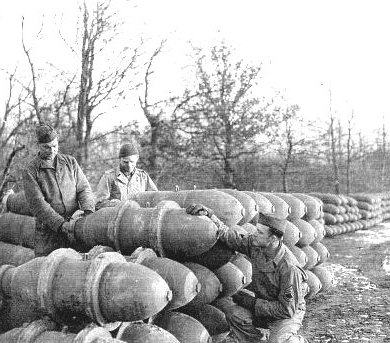 T/Sgt. Harold A. Brown inspecting fuse cavities at the 1681st Ord. Co. Bomb Dump |
- Napalm Bombs
- In the latter half of 1944 a refined petroleum jelly called Napalm became available. Known as Class-C Fire Bombs and with a capacity of 108 US gallons, these bombs were only used in few missions. A B-17 carried four such bombs with tiny igniter units fitted to each tank.
- Fragmentation Bombs
- Used as anti-personnel bombs during ground force support attacks, these 20lb M41's were fitted in 120lb and 500lb clusters. They were very light bombs and the B-17 Norden bombsight had to be used with a special computation table to provide the maximum trail angle (distance between plane and point of impact).
- Poison Gas Bombs
- Poison gas bombs were kept in stock as a deterrent throughout the war by the US 8th Air Force. They consisted of two types, both made in Britain; the 400lb "Flying Cow" mustard gas bomb and the 500lb phosgene bomb.
- VB-1 AZON-Bomb
- A basic 1000lb bomb, but with a special tail attachment which allowed it to be steered over a distance of 200 feet to either side of the point of impact from a heigh of 20,000 feet. They were controlled by the dropping aircraft using an AN/ARW-9 transmitter. The bomb could only be attached to a B-24 on a 2000lb bomb shackle.
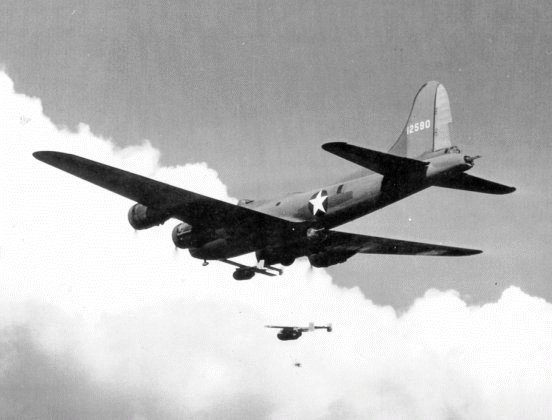
Glide Bomb Training in the USA
- GB-1 Glide Bomb
- This was made from a M34-2000lb bomb fixed to a 12 foot span glider unit and attached to a B-17 underwing shackle. Two Glide bombs could be carried per plane. Essentially free fall, the bomb had a stabilizing device that allowed control of direction. The bomb proved to be unreliable on the only occasion it was used on Cologne in April 1944.
- GB-4
- A radio controlled bomb with a TV camera fitted in the nose section that transmitted a TV signal over a range of 15 miles. It was only ever used on one plane, a B-17, on a single combat sortie.
- Disney Rocket Bomb
- This 4500lb bomb was designed for penetrating the thick concrete U-boat shelters. It was free-fall until a rocket motor fired at 5,000 feet, pushing the missile to speeds of 2,400 feet per second upon impact. It could penetrate 20 feet in solid concrete before explosion and was first used by 92nd Bomb Group on 14th March 1945.
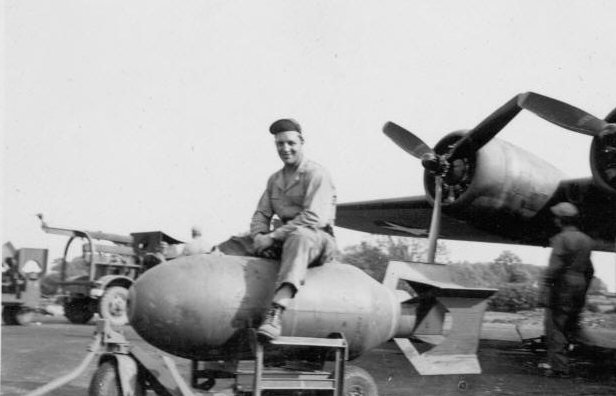
Unknown 359th BS Ground Crewman on a 2000 LB Bomb